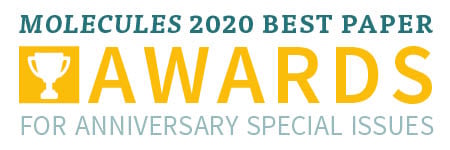25th Anniversary of Molecules—Recent Advances in Nanochemistry
A special issue of Molecules (ISSN 1420-3049). This special issue belongs to the section "Nanochemistry".
Deadline for manuscript submissions: closed (30 September 2020) | Viewed by 112123
Special Issue Editors
Interests: materials; synthesis; characterization; material application for energy harvesting; devices for sensing; optical and electrical devices
Special Issues, Collections and Topics in MDPI journals
Special Issue Information
Dear Colleagues,
In this Special Issue, we invite investigators to contribute original research articles as well as review articles related to novel methods and applications of Nanochemistry. We are particularly interested in research topics including:
- synthesis, assembly, characterization, dynamics, measurement, theory and simulation of organic, inorganic, polymer, and hybrid nanomaterials;
- nanofabrication and nanodevices for electronic, photonic, magnetic, optoelectronic and electro-mechanical applications;
- nanoscale materials and systems for biomedical, chemical, environmental and energy applications, including but not limited to diagnostics, imaging, biosensing, therapeutics, drug delivery, fluidics, catalysis, batteries, solar cells and energy harvesting devices;
- synthesis and application of biomimetic or bio-inspired nanomaterials.
In recognition of our authors’ continued support, Molecules is pleased to announce that the “Molecules Best Paper Awards for Anniversary Special Issues” will be launched and granted to the best papers published in the this Anniversary Special Issue. See details at: https://www.mdpi.com/journal/molecules/awards
Prof. Dr. Magnus Willander
Dr. Peng Si
Guest Editors
Manuscript Submission Information
Manuscripts should be submitted online at www.mdpi.com by registering and logging in to this website. Once you are registered, click here to go to the submission form. Manuscripts can be submitted until the deadline. All submissions that pass pre-check are peer-reviewed. Accepted papers will be published continuously in the journal (as soon as accepted) and will be listed together on the special issue website. Research articles, review articles as well as short communications are invited. For planned papers, a title and short abstract (about 100 words) can be sent to the Editorial Office for announcement on this website.
Submitted manuscripts should not have been published previously, nor be under consideration for publication elsewhere (except conference proceedings papers). All manuscripts are thoroughly refereed through a single-blind peer-review process. A guide for authors and other relevant information for submission of manuscripts is available on the Instructions for Authors page. Molecules is an international peer-reviewed open access semimonthly journal published by MDPI.
Please visit the Instructions for Authors page before submitting a manuscript. The Article Processing Charge (APC) for publication in this open access journal is 2700 CHF (Swiss Francs). Submitted papers should be well formatted and use good English. Authors may use MDPI's English editing service prior to publication or during author revisions.
Keywords
- nanochemistry
- nanomaterials
- nanostructures
- nanocrystals
- nanoparticles
- nanocomposites
- synthesis
- characterization
- assembly
- molecular nanoscience
- nanomedicine
- nanobiotechnology
- nanocatalysis
- nanodevices
- nanofluidics
- nanosensors
- nano-optics
- nano-optoelectronics
- nanophotonics
- nanomagnetics
- nanochips
- nanofabrication
Benefits of Publishing in a Special Issue
- Ease of navigation: Grouping papers by topic helps scholars navigate broad scope journals more efficiently.
- Greater discoverability: Special Issues support the reach and impact of scientific research. Articles in Special Issues are more discoverable and cited more frequently.
- Expansion of research network: Special Issues facilitate connections among authors, fostering scientific collaborations.
- External promotion: Articles in Special Issues are often promoted through the journal's social media, increasing their visibility.
- e-Book format: Special Issues with more than 10 articles can be published as dedicated e-books, ensuring wide and rapid dissemination.
Further information on MDPI's Special Issue polices can be found here.








